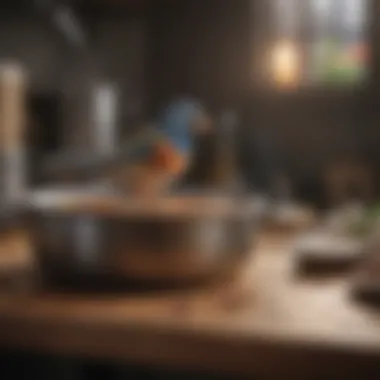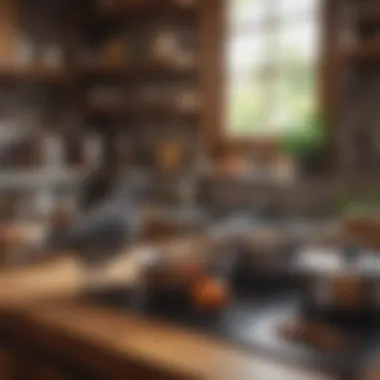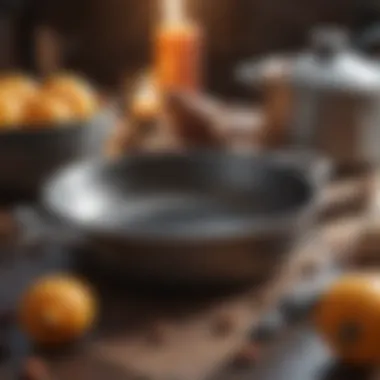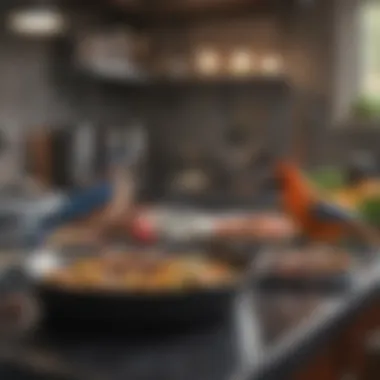Essential Guide to Cookware Safety for Birds


Intro
Pet birds are beloved companions, bringing joy and personality to our homes. As owners, we hold the responsibility to ensure their health and wellbeing, especially in environments where cooking happens. The cookware we choose can have significant implications for their safety. This guide seeks to educate bird owners on the various materials and potential hazards associated with cookware, offering a comprehensive approach to creating a safe cooking environment.
Understanding Your Pet
Looking after a pet bird requires a deep understanding of their behavior and needs. Each species has unique traits, which inform how we maintain a safe atmosphere in our kitchens.
Pet Behavior Basics
Bird behavior is distinct. They are naturally curious and tend to explore their surroundings, including the kitchen. This behavior necessitates a vigilant approach to safety. Hazards such as hot surfaces or toxic materials can lead to serious health issues. Owners should recognize when their birds are investigating their environment and take precautions accordingly.
Common Breed Characteristics
Different species of pet birds exhibit different characteristics. Parrots may be more inclined to chew on objects, including cookware, while smaller birds like finches may show less interest. It’s crucial for owners to understand these tendencies to tailor their cooking space. Choosing bird-safe materials is vital.
Species-Specific Needs
Each bird species has specific needs. For instance, some birds may benefit from certain materials in their environment, while others might be more sensitive to chemicals found in cookware. Owners should research their bird's requirements to avoid toxic exposure and ensure a safe space for them to interact.
Cookware Materials and Safety
Selecting the right cookware is key to preventing health risks for pet birds. Here are some common materials found in cookware along with their safety evaluations:
- Stainless Steel: Generally safe, non-reactive, and durable. It does not release harmful gases or chemicals.
- Ceramic: High-quality, lead-free ceramics are safe, but lower-quality versions may leach toxins.
- Non-stick Coatings: These can be harmful, especially if they contain polytetrafluoroethylene (PTFE). Birds can be sensitive to fumes, which can be fatal.
- Aluminum: There is some debate about its safety. It is best to avoid aluminum cookware to reduce potential health risks.
Always prioritize bird-safe cookware to reduce risks of toxicity.
Cookware Hazards to Avoid
Understanding hazards is just as crucial as selecting safe materials. Owners should remain vigilant about:
- Fumes from Heating: Non-stick pans can emit fumes that are dangerous to birds.
- Chemicals in Cookware: Look for cookware free from potentially harmful chemicals, such as lead and cadmium.
- Sharp Edges: Ensure all cookware is smooth and free of sharp edges to prevent injuries.
Recommendations for Bird-Safe Cooking
Creating a bird-safe kitchen environment can seem challenging, but there are guidelines that can simplify the process:
- Use only stainless steel, ceramic, or high-quality glass cookware.
- Avoid using non-stick cookware that contains PTFE.
- Ensure proper ventilation during cooking to disperse any potential harmful fumes.
- Store cookware safely out of reach of your birds.
Synthesizing Information


In summary, the safety of pet birds in the kitchen hinges on choosing the right cookware and understanding the associated risks. Knowledge about materials, hazards, and specific needs can significantly minimize potential health issues related to cooking. Bird owners must remain proactive to ensure their avian companions have a safe environment, allowing both parties to enjoy the time spent together.
As we dive deeper into bird care and maintenance, the subsequent sections will reinforce how overall pet care practices contribute to the wellness and safety of our feathered friends.
Understanding Bird Safety
Understanding safety for birds is paramount for anyone who shares their home with these delicate creatures. Birds have unique respiratory systems that make them particularly sensitive to airborne chemicals and toxins. Many common household items, including cookware, can emit harmful substances that may jeopardize the health of these pets. By choosing the proper cookware, owners can significantly reduce risks and contribute to the well-being of their feathered companions.
The Unique Physiology of Birds
Birds possess a highly specialized physiology that is distinct from mammals. Their lungs are structured to provide a constant flow of air, allowing for efficient gas exchange. This means that they are more susceptible to inhaling toxic substances than humans. Any exposure to fumes, especially those from non-stick pans or other hazardous materials, can be detrimental. Understanding these physiological traits is vital when considering the safety of cooking items. The respiratory system of a bird does not have the same barriers that a mammal might have, making them vulnerable to dangerous chemicals.
Importance of Cookware Choices
The choice of cookware directly impacts the safety of birds in the household. Certain materials are more hazardous than others. Non-stick coatings, for example, can release toxic fumes when overheated. Likewise, aluminum cookware may contribute to health issues, as birds are sensitive to metals. When selecting cookware, bird owners must carefully evaluate materials that pose less of a threat to their pets.
Understanding and thoughtful selection in cookware choices can create a safer environment for birds. By simply opting for safer alternatives like stainless steel or ceramic, potential risks can be mitigated. Educating oneself about these factors is crucial to ensuring a harmonious living space for both humans and birds.
Common Cookware Materials
Understanding the cookware materials is crucial for ensuring the safety of pet birds. Each type of cookware carries its unique properties, advantages, and potential risks. By becoming familiar with these materials, bird owners can make informed decisions that will protect their avian companions from harm. This section examines various cookware options that are commonly used in kitchens around the world.
Non-stick Cookware: Risks Involved
Non-stick cookware is popular in many households due to its convenience and ease of cleaning. However, it poses significant risks for birds. Many non-stick surfaces contain polytetrafluoroethylene (PTFE), which can release toxic fumes when heated to high temperatures. These fumes are particularly harmful to birds, as their respiratory systems are highly sensitive. Exposure to these fumes can lead to a condition known as
Toxic Materials to Avoid
Understanding which materials are unsafe is crucial for bird owners. Toxic cookware can pose serious health threats to your feathered companions. Being aware of these dangers helps you make informed decisions when selecting cookware options. Here we discuss often encountered hazardous materials in cookware and what warnings to heed.
PTFE and PFOA: Non-stick Concerns
PTFE, or Polytetrafluoroethylene, is a common non-stick coating found in pans and bakeware. Though convenient, it can become hazardous when overheated. Birds are especially sensitive to fumes released from overheating PTFE-coated cookware. These fumes can cause severe respiratory issues and even be fatal.
PFOA, or Perfluorooctanoic acid, was previously used in the production of PTFE. While many manufacturers no longer use it, the risks associated with it remain relevant for vintage or second-hand items. Ensuring that your cookware is PFOA-free is essential to safeguard your bird's health. Check labels and manufacturer specifics to make certain.
Important: When cooking, avoid preheating non-stick pans empty, as this raises the temperature quickly and can emit toxic fumes.
Aluminum Cookware: Potential Hazards
Aluminum cookware is lightweight and popular amongst many home cooks. However, there are concerns linked to its use, particularly if aluminum items are scratched or damaged. Such conditions could lead to aluminum leaching into food or air, which poses a health risk for both humans and birds.
Some studies suggest that excess aluminum exposure may contribute to neurological issues. Although research on this is still ongoing, minimizing contact between birds and aluminum cookware is advisable. Using alternatives can result in a safer, worry-free cooking experience for you and your avian friends.


Lead and Cadmium: Risks from Certain Glazes
Lead and cadmium are often found in glazed pottery and ceramic cookware. These heavy metals pose significant risks, especially during high-heat cooking. Birds can suffer from toxic exposure if they ingest particles or fumes from these materials.
While many manufacturers have shifted to safer practices, vintage items should be treated carefully. If you own antiques or second-hand cookware, it is wise to have them tested for lead and cadmium. Always prefer cookware that explicitly states it is free of these hazardous substances.
Choosing appropriate cookware materials is vital for your pet bird's safety. Awareness of what to avoid in your kitchen leads to healthier choices overall.
Choosing Bird-safe Cookware
Choosing the right cookware for a bird-friendly kitchen is essential for the safety and health of your avian companion. Various cookware materials can release harmful chemicals or substances that may pose risks to birds. Being aware of which types of cookware are safe and which are not allows pet owners to create an environment that minimizes exposure to toxins. The right choices can help prevent respiratory issues and other serious health problems for your bird. Understanding this subject can lead to informed decisions that protect your pet's well-being.
Factors to Consider
When selecting bird-safe cookware, several critical factors must be taken into account:
- Material Type: Opt for materials that are known to be safe, such as stainless steel, cast iron, or glass. Avoid non-stick surfaces that can emit harmful fumes.
- Coatings: Cookware with chemical coatings may contain substances that are harmful to birds. Always check for any health warnings or safety certifications.
- Heating Capabilities: Some cookware materials can release substances when heated to high temperatures. It's wise to consider the cooking methods you use and how they affect the cookware.
- Compatibility: Evaluate how the cookware fits into your cooking style and lifestyle. Some materials require more maintenance than others, which can affect your decision.
- Weight and Durability: Heavier cookware, like cast iron, can be sturdier, while lighter options may be easier to handle. Consider your comfort and the impact on your kitchen activities.
It is essential to weigh these factors carefully to ensure that your cookware choice aligns with both safety and practicality.
Recommended Brands and Products
When looking for bird-safe cookware, choosing trusted brands can make a difference. Here are some brands known for their commitment to safety:
- All-Clad: Known for high-quality stainless steel cookware, All-Clad products are durable and do not contain harmful coatings.
- Lodge: Their cast iron cookware is safe for birds and offers excellent heat retention with proper care.
- Pyrex: A trusted name for glass cookware, Pyrex is both safe and versatile, making it a strong contender in bird-safe options.
- Scanpan: This brand offers a ceramic-based non-stick option that is designed to be safer compared to traditional non-stick cookware.
When exploring cookware choices, always ensure that products are labeled as non-toxic and free from harmful chemicals. Also, pay attention to customer reviews and product descriptions related to safety features. Making the right selection can significantly contribute to the safety of your home for both the humans and birds living in it.
Important Note: Always consult sources like Wikipedia or Britannica for detailed information on cookware safety and materials, especially when considering specific products.
Best Practices for Bird Owners
When it comes to ensuring the safety of pet birds in a home, one of the most critical aspects lies in adopting best practices in cookware usage. Bird owners often overlook how everyday cooking can introduce unseen hazards. By implementing safety measures, owners can significantly reduce the risk of exposure to harmful materials. This section will explore specific actions that help in maintaining a secure environment while preparing meals.
Creating a Safe Cooking Environment
Establishing a safe cooking environment is paramount for the well-being of pet birds. Cookware should be chosen with care, and all cooking activities should be conducted with the birds' health in mind. Here are some key considerations:
- Location of Birdcage: Ensure that the birdcage is placed away from the kitchen. This limits the birds' exposure to fumes, smoke, and other airborne irritants that may arise during cooking.
- Use Bird-safe Cookware: Choose cookware that does not emit toxic gases. For instance, opt for stainless steel or cast iron, as they are safer than non-stick varieties.
- Maintain Cleanliness: Regularly clean cookware to avoid the buildup of harmful residues. Grease and burnt food can generate smoke that is hazardous to birds.
- Avoid Cooking with Open Flame: Cooking methods that involve open flames can produce harmful smoke. Even well-ventilated areas may not eliminate the risk completely.
These proactive steps can help create a safer atmosphere, prioritizing the health of your avian companions.


Monitoring Fumes and Odors
Another important aspect of bird safety in the kitchen is to monitor fumes and odors during cooking. Birds possess a highly sensitive respiratory system, making them susceptible to airborne toxins. Here are effective ways to minimize risks:
- Use Ventilation Systems: Keep kitchen windows open and use exhaust fans to reduce buildup of fumes and odors. This increases airflow and helps disperse any potentially harmful substances.
- Choose Low-Emission Cooking Methods: Methods that produce minimal smoke and odors, such as steaming or slow cooking, are preferable for households with birds.
- Avoid Scented Candles and Air Fresheners: These products can release chemicals that may be harmful to birds. Stick with natural alternatives or essential oils that are known to be safe for avians.
- Regularly Check for Unusual Odors: If you notice unfamiliar smells during cooking, investigate immediately. It may indicate a problem with cookware or an inadvertent use of toxic substances.
The Role of Ventilation
Proper ventilation plays a critical role in maintaining a safe environment for both your pet birds and your household. Birds have delicate respiratory systems, making them particularly vulnerable to airborne toxins and pollutants. An effective ventilation system helps to dilute harmful gases, smoke, and kitchen odors that can arise during cooking.
Ensuring sufficient airflow not only protects your avian companions but also supports overall indoor air quality. Poor ventilation can lead to a buildup of fumes from cooking appliances, which includes substances that might be harmful to birds.
Importance of Proper Airflow
Airflow is essential for the health and well-being of pet birds. It dilutes and disperses any toxic fumes that may be emitted from cooking. Proper airflow can mitigate the risks associated with non-stick cookware releasing harmful chemicals into the air. When using items such as Teflon-coated pans, keeping an open window or using exhaust fans can help ventilate the space quickly.
Birds are also better able to flourish in an environment where fresh air circulates continuously. Areas with stagnant air may increase the likelihood of respiratory issues and stress among your birds. Factors to consider for maintaining proper airflow include:
- Open windows whenever possible to allow outdoor air to circulate.
- Use exhaust fans during and after cooking.
- Avoid crowded spaces in the kitchen where airflow is limited.
Tips for Effective Ventilation
To maximize safety for your pet birds while cooking, implementing effective ventilation strategies is key. Here are several practical approaches you can take:
- Install a range hood: Consider a range hood that vents to the outdoors, which helps to eliminate airborne particles and odors before they circulate into your living space.
- Air purifiers: Use HEPA air purifiers to capture small particles and improve air quality. Make sure that any purifier is placed away from your birds to prevent them from inhaling any harmful chemicals used in the purifier itself.
- Create cross-ventilation: When possible, open multiple windows to create a cross-breeze. This helps to distribute fresh air more effectively throughout the kitchen.
- Monitor humidity: Excess moisture can lead to mold growth, which is not only unhealthy for humans but can also pose risks to bird health. Use dehumidifiers if necessary to maintain optimal humidity levels.
Using proper ventilation techniques can significantly enhance the safety of your bird's environment. It's not just about cooking; it's about sustaining a healthy living space for them.
By prioritizing ventilation, you establish an atmosphere where your birds can thrive. Choosing the right strategies can prevent the accumulation of harmful substances, benefitting both your pet birds and your overall household health.
Resources for Bird Owners
When it comes to ensuring the well-being of pet birds, access to accurate and reliable resources is crucial. The safety of these avian companions, particularly regarding cookware, depends not only on what is easy to find but also on the quality of information at hand. It is essential to highlight some specific elements related to resources for bird owners, spanning educational material, consultation with experts, and community support.
Access to reliable information can prevent costly mistakes and, more importantly, unfortunate accidents related to bird safety in the kitchen. This knowledge base equips bird owners with understanding the risks related to cookware materials and facilitates more informed decision-making processes.
Educational Material and Guides
Educational materials provide bird owners with foundational knowledge regarding safe practices in the kitchen environment. Books, articles, and online guides delve deep into various topics such as suitable cookware materials, signs of distress in birds, and toxic substances to watch for. These resources may often contain individual experiences from other bird owners which can enrich the learning process.
Here are some useful sources for educational materials:
- Books specialized in avian care, such as The Bird Owner’s Manual.
- Online platforms like Wikipedia or Britannica can provide in-depth articles about potential hazards.
- Websites dedicated to bird care, which often include blogs and articles written by avian specialists.
Consulting Veterinary Experts
Consultation with veterinary experts is another crucial resource for bird owners. A veterinarian who specializes in avian care can offer personalized advice based on the specific needs of your bird. Regular check-ups and open discussions help in addressing any concerns about cookware safety or any other potential health risks.
Veterinarians can also assist in staying updated with the latest findings on avian health. They can guide on which products to trust and which to avoid in the market. Additionally, they often have access to forums or networks of other professionals dedicated to avian health. It's important to build a reliable relationship with a vet who understands your pet's unique needs.







